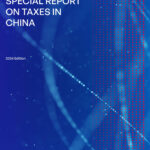Businesses involved in international transactions in China need a clear understanding of China’s withholding tax system. If a company is non-resident and carries out international transactions, withholding tax will be applicable. The withholding tax system in the country is complex, characterized by a variety of regulations and rates that require careful consideration to ensure efficient and compliant operations.
This article presents a detailed overview of withholding taxes in China, offering guidance to foreign businesses on navigating these complexities for enhanced financial operations. Specifically, it will cover the scope of withholding tax applications, the classifications of different companies for withholding tax payment, and the processes involved in filing withholding tax in China.
For a comprehensive overview on taxes in china check out our Special Tax Report 2023:

Special Report on Taxes in China
With China holding an increasingly significant position in the global economy, it is important...
Read moreWhat is Withholding Tax?
Withholding tax is defined as the Corporate Income Tax levied on foreign-invested enterprises without permanent establishment in China, that generate China-sourced income. The withholding tax due on profits, must be withheld, or subtracted from profits, before it is paid out to company shareholders. Withholding taxes are of critical importance concerning profit repatriation from China. Generally, withholding taxes are applicable to several categories of China-sourced income including dividends, rents, interest, and royalties.
Any income that is derived in China by a foreign-invested enterprise is withheld by the entity based in China and will be taxed by authorities at a rate of 10%. However, It is important to note that if a foreign company resides in a country or region that has a Double Tax Agreement (DTA) with the People’s Republic of China, and if the DTA specifies a lower withholding tax rate for certain criteria, the foreign company has the option to apply for the reduced withholding tax rate (normally 5%).The withholding tax rate has been as high as 20% in the past, and may change again, pending regulatory updates.
Company Classifications for Withholding Tax Payment
Foreign-invested enterprises in China, including wholly foreign-owned enterprises (WFOE), Chinese-foreign joint ventures and special purpose vehicle companies are required to adhere to withholding tax regulations. The consideration of withholding taxes in China is based on the tax residency status of companies:
TRE companies: TRE, or tax resident enterprises, are not subject to withholding tax. Their worldwide earnings are subject regular income tax.
Non-TRE companies: These are companies that operate within China but have an official tax residency outside China. Such companies are liable for regular income tax on their earnings generated within China, in addition to facing withholding tax on their China-sourced passive income.
The Withholding Entity
The China-based entity serves as the withholding entity, responsible for paying the tax and filing a withholding tax return to document the taxes paid throughout the year. It is important to note that this tax return functions as a reconciliation; the foreign parties are not required to directly make the tax payment. This is because the entity assumes the responsibility of deducting the necessary amount from the passive income and remitting it to the Chinese tax authorities before the foreign investors receive the funds.
How to File Withholding Tax
Here is an overview of the basic procedures for filing withholding tax. The specific rates may vary based on the tax residence of the foreign entity or individual.
Calculating Withholding Tax
The formula for calculating withholding tax liability is as follows:
Tax Rate x Taxable Income = Withholding Tax Payable
The applicable tax rate for dividend withholding tax is determined by the existence of tax treaties and specific provisions. Various tax rate provisions are outlined in individual tax treaties and arrangements (for further details, refer to the official source on tax treaties).For instance, Hong Kong, the United Kingdom, and Singapore have tax treaty rates lower than 10%, and these lower rates are adopted. However, if the respective tax treaty rate exceeds 10%, a standard 10% rate is applied.
The gross amount remitted before any deductions, including business tax, constitutes the taxable amount for dividends, interest, rental, and royalty income. In instances where the payer covers both the withholding tax and business tax, the taxable income is determined by aggregating the total income amount.
Deemed Profit Rates
The taxable profits in China are typically determined based on a deemed profit rate. Historically, a deemed profit rate of 40% was maintained, resulting in an effective 10% withholding tax rate. However, in recent times, most Tax Bureaus accept a deemed profit rate of 30%, leading to a reduced effective withholding tax rate of 7.5%.
This deemed profit rate varies by industry, ranging from 15% to 50% of revenue. Higher rates are applied to management and consulting services, which are deemed to have a 30-50% profit. Construction, design, and architectural projects generally have a 15-30% deemed profit, while income-producing activities in other industries have a 15% rate. This deemed profit serves as the basis for calculating income subject to withholding tax.
Processes for Filing Withholding Tax
The withholding entity, often referred to as the payer, holds the responsibility for both filing and remitting the withholding tax. This involves determining the accurate tax amount, completing the relevant tax form, and submitting it to the Chinese tax authorities. Typically, the deadline for filing withholding tax falls within 15 days of the conclusion of the income-earning period.
Anti-avoidance rules
China has implemented regulations to restrict and discourage tax-avoidance practices that could be employed to bypass withholding tax and other taxes. Typically, these regulations necessitate a legitimate reason, subject to scrutiny by tax authorities, for any alterations to the tax structure. If a company intends to transition to a different tax framework, alter its country of residence, or operate as a company instead of individuals, the change must be justified by a substantial reason other than simply reducing taxes.
Navigating Uncertainty
Understanding and complying with withholding taxes in the context of international non-tax resident entities or foreign enterprises offering services in China can be challenging. The complexity arises from the application of withholding tax to international transactions, particularly in determining the accurate taxable amount and rate, leading to uncertainties.
To address these complexities, seeking professional advice and assistance from local partners is highly recommended. Additionally, resources such as our special tax report on taxes in China can provide general guidance on tax frameworks and the overall landscape.
For over a decade, MSA has been dedicated to supporting foreign businesses in China through our comprehensive services, including accounting, tax advisory, and corporate setup. Our experienced team possesses a profound understanding of China’s intricate business environment. If you are considering collaboration with us, feel free to contact us to schedule a consultation. We are here to assist you in navigating the path to business success in China.





